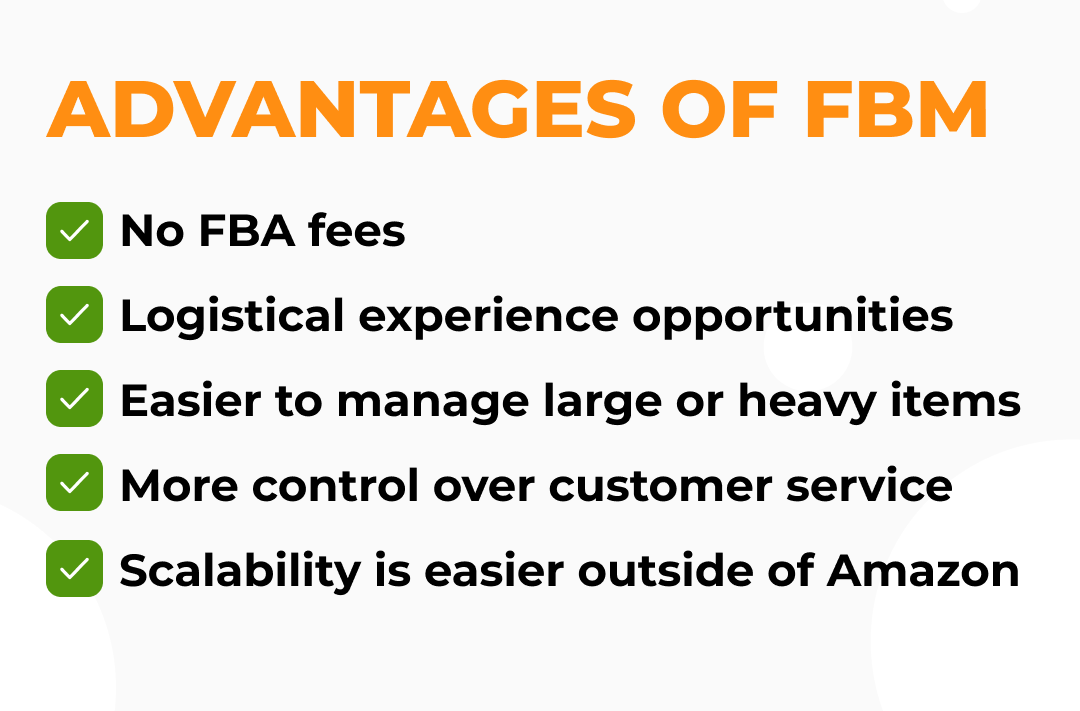.gif)
Last update:
When you sell on Amazon, it's essential to consider your fulfillment method carefully. This method concerns how you get goods out to customers and where you store them while the goods wait. There are two forms that Amazon offers: FBA and FBM.
FBA refers to "Fulfilled By Amazon," requiring you to pay more fees to Amazon.
Those who keep a small inventory, have heavy products, or have unique shipping needs will find this fulfillment method more effective.
So, what about the alternative? This is known as Amazon FBM, which provides a bit more flexibility.
Check out our short guide to find out everything you need to know about this method.
Amazon FBM stands for "Fulfilled By Merchant," which means you handle your products' storage and shipment.
FBM members are considered part of Amazon's Merchant Fulfilled Network (MFN) but won't send their goods to Amazon directly.
FBM sellers will create listings and advertise their products like other sellers.
So, FBM sellers still rely on the same platform as FBA sellers. The difference when using the Amazon platform comes when you create different shipping templates.

If you want to know more about making money on Amazon, check out this guide.
Amazon FBM works differently for individual and professional sellers. The difference is that professional sellers have more flexibility.
Individual sellers use Amazon's pre-set shipping rates for all products. They also have to pay $0.99 per product sale. So, with these two costs in mind, it's essential to set your rates based on profits.
Professional sellers can create their own shipping rates. They use shipping templates that can be customized based on different shipping regions, handling factors, and transit times.
The extra customization lets professional sellers set specific shipping costs for their products.
They don't have to rely on preset rates that don't fit their unique shipping costs.
Regardless, professional and individual sellers must be aware of referral fees. Referral fees are based on a percentage of the total cost of the product (shipping included).
So, the higher your shipping rates are, the more Amazon will take from your profits.
Whether you have an individual or professional account, how you ship the products is entirely up to you.
This increased flexibility highlights the most crucial aspect of FBM: managing your own fulfillment.
FBM fulfillment considerations include the following:
The examples above show an oversimplification of what some FBM sellers consider when choosing this path.
Your business model might decree some of these needs to be unnecessary.
For example, if you keep a small inventory, you might use your garage as temporary storage and handle everything yourself. If the work is overwhelming, FBM sellers might consider outsourcing (like customer service).

Amazon talks a lot about the advantages of FBA, but what about FBM? Below, you'll see a quick list of reasons why you should consider FBM over FBA:
Of course, FBM does come with some unique challenges. Keeping those challenges in mind can help you better prepare for different outcomes.
When everything is up to you, you must hire a staff to manage it. Extra staff members cost money, which is something FBA sellers can delay.
FBA sellers also leverage Amazon's impressive logistical network. Amazon Prime sellers use Amazon's FBA system, giving them higher priority than their FBM counterparts.
However, FBM can overcome this natural advantage through Seller-Fulfilled Prime.
This means you can qualify for top ranking, regardless of whether Amazon holds your inventory. You'll most likely use this for nearby locations, but you can expand it as your logistical capabilities grow.
But this brings us back to the ultimate weakness of FBA: lack of experience.
There are fundamental aspects of the business they will need help understanding in retail, which you'll have a deeper understanding of as an FBM seller.
FBM sellers have to consider their own list of fees. When choosing this selling method, consider these costs:
ShipSaving can help you address the fulfillment costs by providing discounts and connecting you with the most cost-effective options.
The tool can find the best local shipment groups, print the labels, and add them to your package. You can also integrate the tool directly with Amazon.
Besides that, ShipSaving can offer shipping rate discounts of USPS up to 89% off, UPS up to 72% off, and DHL up to 70% off.
Get started for free to discover how it can help your business grow.
Amazon FBM sellers have a few distinct advantages over FBA sellers.
Mainly, those advantages culminate in the form of greater flexibility, experience, and control. So, if those three things appeal to you, consider FBM over FBA.
Those with established logistical networks or experience can also benefit from FBM. You might ship a complex product that most fulfillment centers can't handle. Heavy products, for example, often don't work well with FBA selling.
So, if you consider FBM, look at ShipSaving as your FBM selling support provider.
Written on: